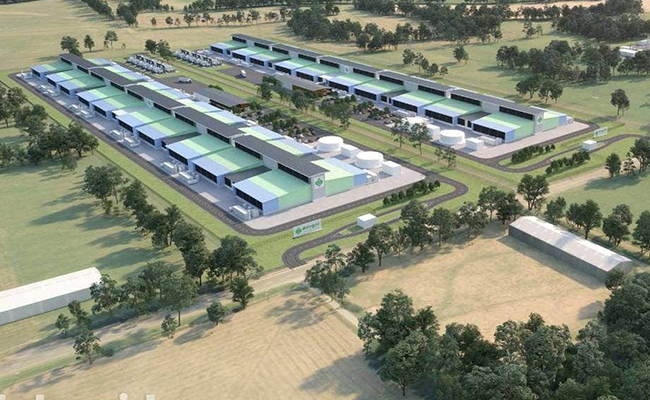Wednesday 1 June 2022 8:48am
 An artist's impression of the Datagrid datacentre
An artist's impression of the Datagrid datacentre
The University of Otago has paved the way to being an anchor tenant in the carbon-neutral datacentre planned for Southland, the first nationwide to mirror those used by companies like Microsoft and Amazon.
University of Otago Chief Operating Officer Stephen Willis says under a strategic agreement with datacentre builder Datagrid, it would develop a customised, future-proof and easily scalable hosting solution to help ensure the University is equipped to manage the exploding volumes of data anticipated as rising numbers of large-scale scientific projects come on stream.
Using the datacentre would mean no longer having to replace aging datacentre with a new facility and could easily scale capacity up or down by ‘renting space’ as needed to meet research, teaching, learning and operational requirements, University Information Technology Services’ Head of IT Infrastructure Wallace Chase says.
The University hopes to start using the hyperscale datacentre in 2024.
Datagrid Chief Executive Officer Remi Galasso says the Southland centre should have a capacity of up to 150MW – for both public and business sectors – at a time when the volume of New Zealand’s research and education data is predicted to dramatically increase as rising numbers of large-scale scientific projects come on stream.
Research benefits
Deputy Vice-Chancellor, Research and Enterprise, Professor Richard Blaikie says, “having a world-leading datacentre ‘next door’ would help Otago’s researchers stay at the forefront of their fields”.
The ability to process, transfer and store enormous digital files has become increasingly vital for researchers worldwide – some of Otago researchers’ most data-intensive work involves MRI scans, genomics, and results from sensors at field research sites.
The new datacentre will build on existing relationships with the New Zealand eScience Infrastructure (NeSI’s) and its national high performance computing facility, along with Research Education Advanced Network New Zealand (REANNZ), a government organisation that aims to meet the unique, complex IT needs of New Zealand’s research, innovation, and education sectors both nationally and internationally, he says.
Sustainability benefits
University of Otago Sustainability Office Head Ray O’Brien says datacentres are usually very energy hungry, so using one powered by 100 per cent renewable energy would help the University in its aim to be net zero carbon by 2030.
Having a datacentre in Southland also follows the social sustainability principle of supporting local people and industries.
Mr Galasso says the renewable energy will come from the Manapouri hydro power scheme, while Southland’s relatively cool annual temperature of 9.8 degrees should make the centre at least 15 per cent more power efficient, lowering cooling costs.
The datacentre’s advanced cooling technology also uses less electricity, and its artificial intelligence focuses on reducing energy costs.
Creating the datacentre
Constructing the datacentre from up to 10 modules on 43 hectares in North Makarewa, near Invercargill, will involve each 6500 square metre module being built and customised in a factory then delivered as a self-contained package of racks (servers, hard disk drives, and other computing equipment), air conditioning, power management, security, monitoring, and fire protection.
Each datacentre module would be deployed in response to demand, modules would be reconfigured as needed to increase flexibility, and could be replaced, repaired, or upgraded without disrupting users.
Modular datacentres can be built quickly by creating infrastructure on-site as the modules are being produced, and construction can be staged to meet demand. The initial build will involve one module costing more than $100 million and should be finished by 2024, Mr Galasso says.
Future connections
Datagrid’s parent company BW Digital could also provide the first ultrafast broadband connection to Antarctica’s scientists at Scott Base – including Otago researchers – which would replace existing less reliable satellite communications.
BW Digital is the strategic partner of the Chilean government’s infrastructure fund Desarrollo Pais which is in developing the Humboldt Cable System to connect Valparaiso in Chile with Sydney in Australia and that cable will include several branches for potential connections to remote areas, including Antarctica.
It would be less than 2,000-kilometre from the Humboldt trunk cable to Antarctica.
BW Digital is also the parent company of Hawaiki company which has independent plans to lay another undersea cable – the 22,000-kilometre Hawaiki Nui Cable – and Mr Chase says our University is exploring becoming its land base in Dunedin, which would create a new internet gateway for the whole city.
Mr Galasso says the previously announced Hawaiki Nui Cable would connect Christchurch, Dunedin, and Invercargill while also linking them – via Sydney – to Los Angeles, Hawaii, Singapore, and Indonesia’s Jakarta and Batam.
The South Island centres would have access to the Hawaiki Nui Cable’s ‘domestic’ route in Australia as well, which includes Darwin, Brisbane, and Melbourne.
“Benefiting from 100 per cent hydro power and Hawaiki Nui’s subsea connectivity, Datagrid will enable customers to securely store their core IT infrastructure and access global cloud service providers in a very cost-effective way,” he says.
The Southland datacentre and Hawaiki Nui cable are projected to cost more than $1 billion. They would build on the 15,000-kilometre Hawaiki Transpacific Cable – a $500 million investment – which started connecting the North Island to Australia, the Pacific and west coast of the United States in 2018.
